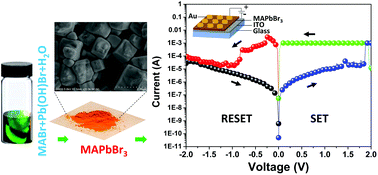Aqueous phase fabrication and conversion of Pb(OH)Br into a CH3NH3PbBr3 perovskite and its application in resistive memory switching devices†
Abstract
Organometal halide perovskites (OMHPs) have shown promising applications in solar cells, light-emitting diodes, and photodetectors. However, besides the toxic lead, the intensive usage of organic solvents during their fabrication could induce severe environmental pollution. Therefore, green-solvent fabrication of OMHPs is highly desirable but extremely challenging. Herein, we report aqueous phase fabrication and conversion of laurionite-type Pb(OH)Br into CH3NH3PbBr3. The prepared CH3NH3PbBr3 crystals show prominently enhanced environmental and thermal stability compared to those prepared in organic phases. To demonstrate the application of the prepared CH3NH3PbBr3, a resistive switching memory device (ReRAM) is fabricated. The ReRAM devices exhibit good bipolar non-volatile characteristics that can remain unchanged for more than 30 days under ambient conditions. We believe that the aqueous phase-based green fabrication process of OMHPs will not only greatly alleviate the environmental pollution during or after their commercialization process, but will also provide a new concept in stabilizing and improving the performance of OMHP-based devices.



 Please wait while we load your content...
Please wait while we load your content...